Each Month in Crescent Garden
See what the Crescent Garden offers each month throughout the year.
January
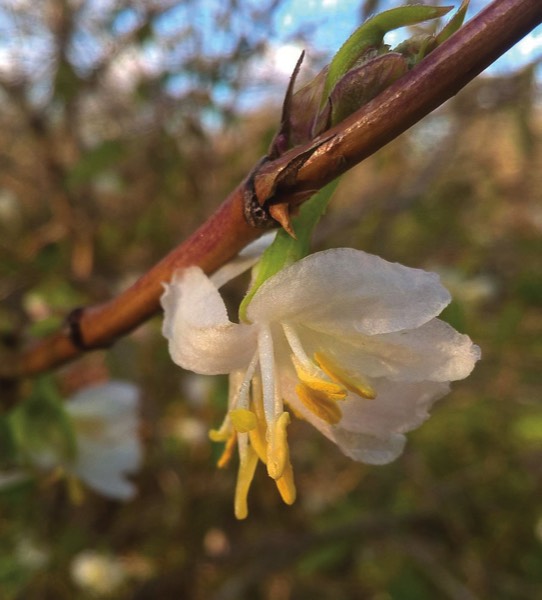
Lonicera Fragrantissima
As you enter the far eastern gate into Crescent Garden you may, if the atmospheric conditions are right, be overwhelmed by a glorious perfume; maybe for you a mixture of citrus and vanilla. This perfume comes from a bush only a few steps along the path into the garden. It is winter honeysuckle (Lonicera fragrantissima). Unlike the more familiar summer flowering honeysuckle this species is not a climber, but forms a tangle of bushy slender spreading branches. The flowers are small, white and rather insignificant looking, but are full of nectar and pollen which attract any winter pollinators which are braving the cold weather. The larger the insect, the more readily can it survive cold conditions and bumble bees are sometimes seen in mid-winter. If you did not smell it as you entered the garden, go up close, seek out the flowers and bury your nose in one to get the full effect of the fragrance.
The almost leafless branches continue producing flowers from December through to March. After flowering the bush can be cut back hard if necessary, as the next year’s flowers will develop on new growth produced during the summer. The plant enjoys sun, but is also happy in partial shade. It will grow in almost any soil, is very easy to care for and is attacked by almost no pests. So it is an ideal bush for your own garden, especially planted alongside a path or just outside a door where you will get the full benefit of the perfume. In the spring when flowering is finished, berries form which provide birds with food. There is another Lonicera fragrantissima in the garden among shrubs towards the western end of Terrace Walk.
The plant is native to China and was introduced into Britain in about 1840 by Robert Fortune a plant hunter working for the Royal Horticultural Society. It was grown at Wisley, but other early plants were grown at Hatfield House, home of the Marquess of Salisbury. It can now be found in many parks and gardens all over Britain and has been introduced to many countries worldwide. In some it has become an invasive pest; for example some states in USA. Fortunately that seems unlikely to happen in this country, so we can happily grow it and enjoy its winter perfume.
Rita Rundle
Crescent Garden, Crescent Road, Alverstoke
alverstokecrescentgarden.co.uk
The almost leafless branches continue producing flowers from December through to March. After flowering the bush can be cut back hard if necessary, as the next year’s flowers will develop on new growth produced during the summer. The plant enjoys sun, but is also happy in partial shade. It will grow in almost any soil, is very easy to care for and is attacked by almost no pests. So it is an ideal bush for your own garden, especially planted alongside a path or just outside a door where you will get the full benefit of the perfume. In the spring when flowering is finished, berries form which provide birds with food. There is another Lonicera fragrantissima in the garden among shrubs towards the western end of Terrace Walk.
The plant is native to China and was introduced into Britain in about 1840 by Robert Fortune a plant hunter working for the Royal Horticultural Society. It was grown at Wisley, but other early plants were grown at Hatfield House, home of the Marquess of Salisbury. It can now be found in many parks and gardens all over Britain and has been introduced to many countries worldwide. In some it has become an invasive pest; for example some states in USA. Fortunately that seems unlikely to happen in this country, so we can happily grow it and enjoy its winter perfume.
Rita Rundle
Crescent Garden, Crescent Road, Alverstoke
alverstokecrescentgarden.co.uk
February
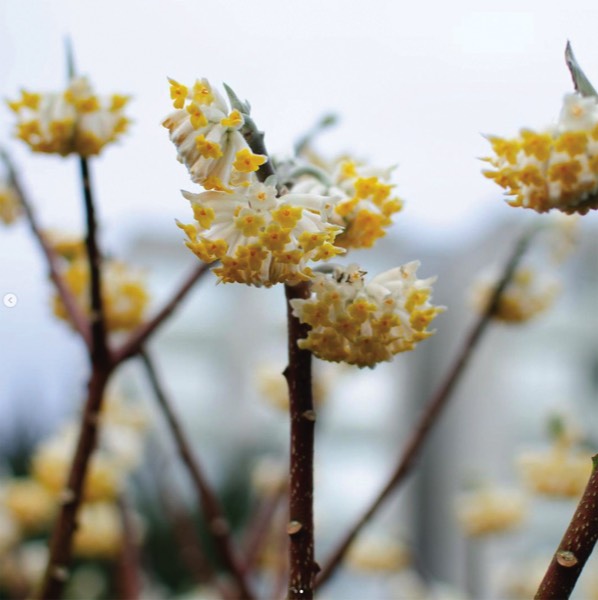
Edgeworthia Chrysantha
As you walk into Crescent Garden and stand in front of the fountain you will see to your left behind the plants immediately around the fountain an umbrella shaped bush with beautiful cinnamon coloured bark and covered in yellow flowers. This is Edgeworthia chrysantha, also called Oriental paper bush. It is a member of the Daphne family (Thymelaeaceae) and is sometimes known as a yellow Daphne. It is native to Myanmar, China, Nepal and Japan. It grows in forests and on shrubby slopes, so will happily grow in partial shade or in the full sun it receives in its position in Crescent Garden. It is also completely resistant to heavy frost such as we had here back in November, unlike some of our other plants. You may notice some blackened plants and empty spaces around the garden due to that spell of weather. The paper bush was much admired by both gardeners and visitors, when it was planted a few years ago, having been given to us by a friend, so another bush was planted along terrace walk in the partial shade which the plant reputedly enjoys, but it has not, so far, been as striking as the one near the fountain.
The plant was named after Michael Pakenham Edgeworth (1812-1881). He was an Irish born Victorian botanist who worked for the East India Company. His job enabled him to travel in the Himalayas and other parts of Asia. Although not a professional plant collector he was much respected and had plants named after him. He was friends with Charles Darwin and William Griffith, a senior botanist of the day, living and working in India and Edgeworth contributed plants to Griffith’s collections. The specific name, chrysantha, is a reference to its yellow colour.
The common name for the plant, paperbush, comes from the fact that fibres in the bark are used in Japan to make mitsumata paper. This is especially durable and Japanese bank notes are manufactured from it. In China, roots, flowers and bark are used in traditional medicine.
In summer the bush bears rather unassuming green foliage, but when that falls in the autumn, little white knobs can be seen at the ends of the bare branches and from January to March or even into April these burst out into attractive yellow globes, about 3 or 4cms across, producing a delicate perfume. Each ‘globe’ contains a multitude of tiny flowers.
All together a pleasing plant adding beauty and interest to the flower beds and being compact a suitable plant for many a garden. Why not try it in yours?
Rita Rundle
Crescent Garden, Crescent Road, Alverstoke
alverstokecrescentgarden.co.uk
The plant was named after Michael Pakenham Edgeworth (1812-1881). He was an Irish born Victorian botanist who worked for the East India Company. His job enabled him to travel in the Himalayas and other parts of Asia. Although not a professional plant collector he was much respected and had plants named after him. He was friends with Charles Darwin and William Griffith, a senior botanist of the day, living and working in India and Edgeworth contributed plants to Griffith’s collections. The specific name, chrysantha, is a reference to its yellow colour.
The common name for the plant, paperbush, comes from the fact that fibres in the bark are used in Japan to make mitsumata paper. This is especially durable and Japanese bank notes are manufactured from it. In China, roots, flowers and bark are used in traditional medicine.
In summer the bush bears rather unassuming green foliage, but when that falls in the autumn, little white knobs can be seen at the ends of the bare branches and from January to March or even into April these burst out into attractive yellow globes, about 3 or 4cms across, producing a delicate perfume. Each ‘globe’ contains a multitude of tiny flowers.
All together a pleasing plant adding beauty and interest to the flower beds and being compact a suitable plant for many a garden. Why not try it in yours?
Rita Rundle
Crescent Garden, Crescent Road, Alverstoke
alverstokecrescentgarden.co.uk
March
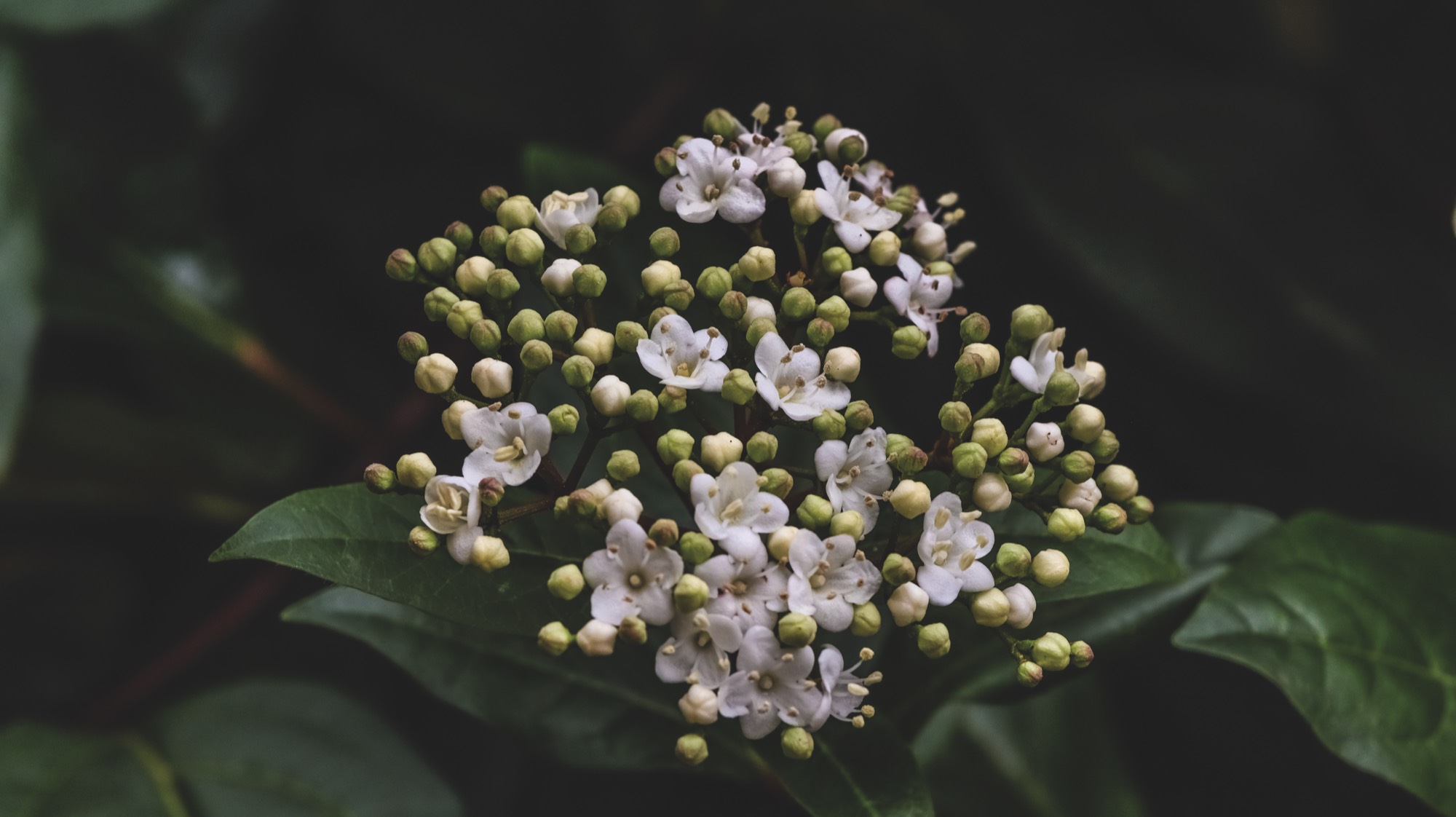
Viburnum Tinus
If you walk down the narrow path into the small garden at the eastern end of Crescent Garden, you will see a small shrub with clusters of delicate white flowers hanging over the path. This is Viburnum tinus. The flowers are fragrant and can appear on the plant any time
between October and April. It is, therefore, a wonderful plant, to provide not only interest in a winter garden, but nectar for winter foraging insects. Following the flowers, dark blue-black fruits are formed. In 2020 a study of the fruit’s metallic blue hue revealed microscopic globules of fat to be the cause; an unusual feature to be found in a plant.
Viburnum is a large genus of 150 to 175 species in the family Adoxaceae and many of them, like V. tinus, are very hardy, so there is hardly a garden in UK that does not have a Viburnum in it. Viburnum tinus is resilient to windy conditions, will grow in full sun or part shade, and in almost any sort of soil as long as it is not waterlogged. It is also disease and insect resistant. It can grow into a large rather straggly bush, but is easily pruned to any size or shape required, sometimes as a hedge.
Viburnum tinus is native to the Mediterranean region and is found in shrubby areas of North Africa, the Near East, Turkey and southern European countries. It has been introduced and grown in European gardens since antiquity. It is, for example, depicted on a fresco in the ruins of Pompeii. Some long straight branches of V. tinus were also found in the hands of ‘the Tyrolean Ice Man’. This was the preserved-in-ice natural mummy of a man who lived between 3350 and 3105 BC. Were these used to make arrows or was he a prehistoric gardener doing a bit of pruning?
It has also been introduced to parts of USA and Australia, Mexico and Madeira.
So, an attractive plant, tough and easy to grow. Why not come and look at the one in Crescent Garden and then get one for your own garden; or even grow it in a pot.
Rita Rundle
Crescent Garden, Crescent Road, Alverstoke
alverstokecrescentgarden.co.uk
between October and April. It is, therefore, a wonderful plant, to provide not only interest in a winter garden, but nectar for winter foraging insects. Following the flowers, dark blue-black fruits are formed. In 2020 a study of the fruit’s metallic blue hue revealed microscopic globules of fat to be the cause; an unusual feature to be found in a plant.
Viburnum is a large genus of 150 to 175 species in the family Adoxaceae and many of them, like V. tinus, are very hardy, so there is hardly a garden in UK that does not have a Viburnum in it. Viburnum tinus is resilient to windy conditions, will grow in full sun or part shade, and in almost any sort of soil as long as it is not waterlogged. It is also disease and insect resistant. It can grow into a large rather straggly bush, but is easily pruned to any size or shape required, sometimes as a hedge.
Viburnum tinus is native to the Mediterranean region and is found in shrubby areas of North Africa, the Near East, Turkey and southern European countries. It has been introduced and grown in European gardens since antiquity. It is, for example, depicted on a fresco in the ruins of Pompeii. Some long straight branches of V. tinus were also found in the hands of ‘the Tyrolean Ice Man’. This was the preserved-in-ice natural mummy of a man who lived between 3350 and 3105 BC. Were these used to make arrows or was he a prehistoric gardener doing a bit of pruning?
It has also been introduced to parts of USA and Australia, Mexico and Madeira.
So, an attractive plant, tough and easy to grow. Why not come and look at the one in Crescent Garden and then get one for your own garden; or even grow it in a pot.
Rita Rundle
Crescent Garden, Crescent Road, Alverstoke
alverstokecrescentgarden.co.uk
April
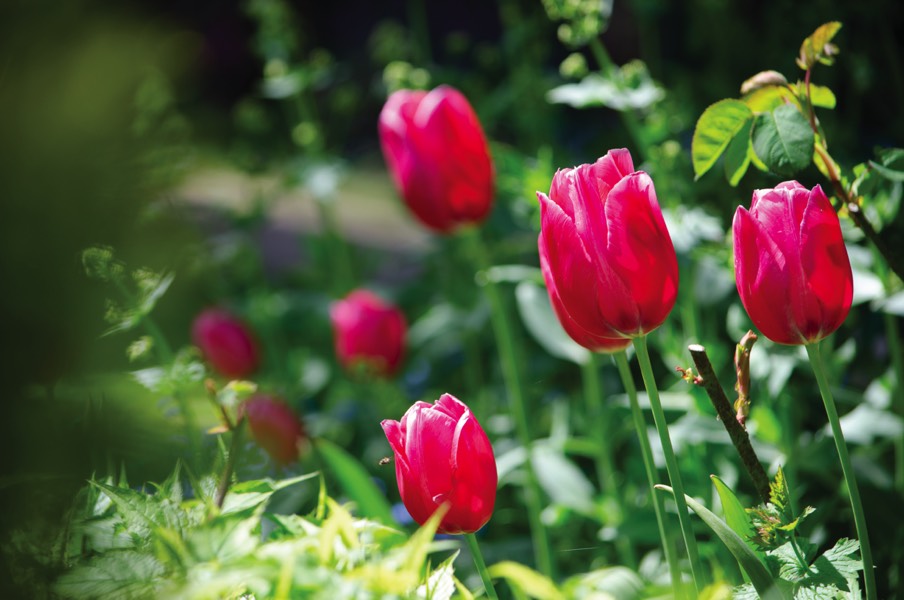
Tulips in the Crescent Garden
There are several tulip varieties in Crescent garden, both in the flower bed next to the railings and those around the fountain.
All tulips are native to countries east of Europe, different varieties coming from Turkey, Iran, Iraq, Afghanistan, Pakistan and the Western Himalayas. When the tulip first arrived in Europe no one knew the name of this exotic novelty until it was mentioned as tulipam in a letter in 1554 from Ogier Ghiselin de Busbecq, the Austrian ambassador to the Ottoman Empire. The story goes that he saw workers in fields of flowers with some of the flowers stuck in their turbans. The ambassador pointed to their heads and asked the name and was told ‘tulbend’, the Turkish for turban, though he really meant the name of the flower there. He then wrote it as tulipam, later latinised as tulipa and in English, tulip. Another simpler tale suggests that the name was given as the shape of the tulip flower can look like a turban. Around 1593 Carolus Clusius, a botanist at the university of Leiden, planted his collection of tulip bulbs around the university and found that tulips tolerated the harsher conditions of Northern Europe. This eventually gave rise to the prosperous trade in bulbs, especially tulips, which still exists in Holland today.
After gaining its independence from Spain in 1581, the Dutch Republics (as it was then called) became the most prosperous country in Europe and had the highest per capita income in the world from 1600 to about 1720. Although a very small state it controlled all the main trade shipping routes across the world with a fleet of over 2,000 ships and had a Dutch colonial empire. Compared to most of the rest of Europe at the time the republic allowed great freedom of thought to its residents; art and science flourished. It was the most highly urbanised country in Europe encouraging free trade and the development of a modern effective stock market. The Netherlands has the oldest stock exchange in the world, founded in 1602 by the Dutch East-India Company.
So, an ideal climate for the famous ‘tulip mania’ to happen. These exotic plants were increasingly imported and grown; the financial institutions of the Dutch Republics allowed tulip bulbs to be bought and sold for fabulous prices, sometimes with no money available to pay the bills. Prices rose from 1634 to 1637 when the crash came and hundreds were ruined. This was the tale believed for more than a century, mainly due to a book written in 1841 by Charles Mackay who used as his sources satirical pamphlets and jokes of the time making fun of those involved. And we all know how close to the truth they can be! It was a dramatic story, which people wanted to believe. Modern research, however, using more reliable archive material, has indicated that relatively few people were involved and that the monetary losses suffered were by wealthy merchants who were quite used to losing money on some deals, making good on the next venture they tried. Some of the human disasters associated with ‘tulip mania’ were actually much more caused by the 30 years war raging across Europe and an outbreak of bubonic plague. Tulips certainly didn’t affect Holland’s overall prosperity, which continued well into the next century.
That’s quite enough history. Let’s get back to Crescent Garden!
There are three main varieties of tulip in the garden; Tulipa clusiana, Tulipa couleur cardinal and Tulipa Kaizerskroon. All the tulips in Crescent Garden are old species tulips; in other words they are not hybrids, produced by years of interbreeding to produce the larger and very varied modern plants. They are plants still much as they were when taken from the wild many years ago.
T. clusiana is a very small tulip, growing only to 6” or 12”. The common name is lady tulip. Its tepals (petal and sepals mixed) are pointed, dark pink with white edges on the outside and white on the inside with dramatic dark stamens. The flower opens and shuts during the day and so presents two very different appearances; open, star shaped and white or closed and mainly pink.
T. Couleur Cardinal was introduced into Britain in 1845 and is a much stronger looking plant than T. clusiana with a taller stem and a bright red flower.
T. Kaizerskroon was introduced in Holland in 1750 and is one of the oldest varieties still available. It has dramatic red and yellow flowers and so blends well with the other two varieties mentioned.
Do come and admire the tulips in Crescent Garden, not only those near the fountain, but search for occasional clumps of them in other places.
Rita Rundle
Crescent Garden, Crescent Road, Alverstoke
alverstokecrescentgarden.co.uk
All tulips are native to countries east of Europe, different varieties coming from Turkey, Iran, Iraq, Afghanistan, Pakistan and the Western Himalayas. When the tulip first arrived in Europe no one knew the name of this exotic novelty until it was mentioned as tulipam in a letter in 1554 from Ogier Ghiselin de Busbecq, the Austrian ambassador to the Ottoman Empire. The story goes that he saw workers in fields of flowers with some of the flowers stuck in their turbans. The ambassador pointed to their heads and asked the name and was told ‘tulbend’, the Turkish for turban, though he really meant the name of the flower there. He then wrote it as tulipam, later latinised as tulipa and in English, tulip. Another simpler tale suggests that the name was given as the shape of the tulip flower can look like a turban. Around 1593 Carolus Clusius, a botanist at the university of Leiden, planted his collection of tulip bulbs around the university and found that tulips tolerated the harsher conditions of Northern Europe. This eventually gave rise to the prosperous trade in bulbs, especially tulips, which still exists in Holland today.
After gaining its independence from Spain in 1581, the Dutch Republics (as it was then called) became the most prosperous country in Europe and had the highest per capita income in the world from 1600 to about 1720. Although a very small state it controlled all the main trade shipping routes across the world with a fleet of over 2,000 ships and had a Dutch colonial empire. Compared to most of the rest of Europe at the time the republic allowed great freedom of thought to its residents; art and science flourished. It was the most highly urbanised country in Europe encouraging free trade and the development of a modern effective stock market. The Netherlands has the oldest stock exchange in the world, founded in 1602 by the Dutch East-India Company.
So, an ideal climate for the famous ‘tulip mania’ to happen. These exotic plants were increasingly imported and grown; the financial institutions of the Dutch Republics allowed tulip bulbs to be bought and sold for fabulous prices, sometimes with no money available to pay the bills. Prices rose from 1634 to 1637 when the crash came and hundreds were ruined. This was the tale believed for more than a century, mainly due to a book written in 1841 by Charles Mackay who used as his sources satirical pamphlets and jokes of the time making fun of those involved. And we all know how close to the truth they can be! It was a dramatic story, which people wanted to believe. Modern research, however, using more reliable archive material, has indicated that relatively few people were involved and that the monetary losses suffered were by wealthy merchants who were quite used to losing money on some deals, making good on the next venture they tried. Some of the human disasters associated with ‘tulip mania’ were actually much more caused by the 30 years war raging across Europe and an outbreak of bubonic plague. Tulips certainly didn’t affect Holland’s overall prosperity, which continued well into the next century.
That’s quite enough history. Let’s get back to Crescent Garden!
There are three main varieties of tulip in the garden; Tulipa clusiana, Tulipa couleur cardinal and Tulipa Kaizerskroon. All the tulips in Crescent Garden are old species tulips; in other words they are not hybrids, produced by years of interbreeding to produce the larger and very varied modern plants. They are plants still much as they were when taken from the wild many years ago.
T. clusiana is a very small tulip, growing only to 6” or 12”. The common name is lady tulip. Its tepals (petal and sepals mixed) are pointed, dark pink with white edges on the outside and white on the inside with dramatic dark stamens. The flower opens and shuts during the day and so presents two very different appearances; open, star shaped and white or closed and mainly pink.
T. Couleur Cardinal was introduced into Britain in 1845 and is a much stronger looking plant than T. clusiana with a taller stem and a bright red flower.
T. Kaizerskroon was introduced in Holland in 1750 and is one of the oldest varieties still available. It has dramatic red and yellow flowers and so blends well with the other two varieties mentioned.
Do come and admire the tulips in Crescent Garden, not only those near the fountain, but search for occasional clumps of them in other places.
Rita Rundle
Crescent Garden, Crescent Road, Alverstoke
alverstokecrescentgarden.co.uk
May
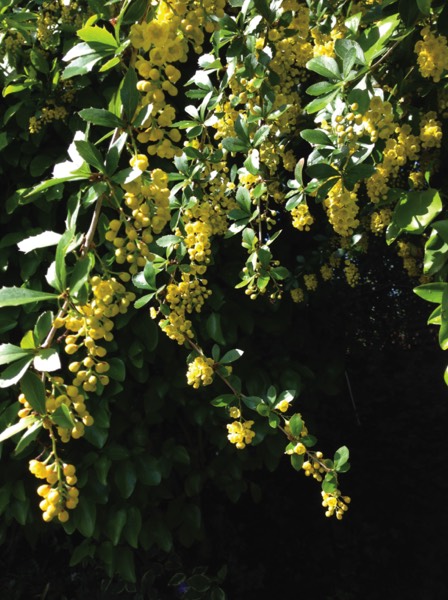
Berberis Aristata
As you go into Crescent Garden by the westernmost gate, you will see on your righthand side a large shrub overhanging the path and almost over the pavement as well. This is Berberis aristata, also known as Indian Barberry. It is native to the Himalayas in India and Nepal. It is also naturally found in the Nilgiri Hills of southern India and in Sri Lanka, but it grows well in many other parts of the world where it has been introduced. It was first seen in the United Kingdom in 1823 and grows well here in a variety of conditions. Although it prefers a warm, moist, loamy soil it will also tolerate thin, dry soils or clayey ones. Plants can also be cut back quite severely if necessary and can be grown as a hedge; the plant is traditionally grown as a living fence in the north-western Himalayas, being good at enclosing animals due to the large three-branched thorns on the stems.
In April and May it has a wonderful display of yellow flowers. Each flower is barely a centimetre across, but they hang in clusters of 11 to 16 called a raceme, making a great show. When the flowers fade, bunches of small berries appear which are eaten in the countries where it grows profusely. Although they are acidic they contain plenty of sugar and other valuable nutrients and can form an important part of the diet in countries to which the plant is native.
So, an easy to grow plant and very hardy. It has been known to survive temperature as low as -15 degrees centigrade, so was not at all affected by the heavy frost we experienced during the past winter.
Parts of the plant are widely used in Chinese and Ayurveda medicine. Most parts of the plant are rich in a chemical called berberine, which is used to treat a wide range of complaints including malaria, eye complaints, skin disease and jaundice. Modern research has indicated that the compound does have a marked anti-bacterial effect and has also shown antitumour activity. A yellow dye is obtained from the root and stem, which is much used in India.
Do come and stroll round Crescent Garden and admire some of the unusual (and usual) plants carefully looked after by volunteer gardeners. Come and see what we are up to on a Wednesday morning.
Rita Rundle
Crescent Garden, Crescent Road, Alverstoke
alverstokecrescentgarden.co.uk
In April and May it has a wonderful display of yellow flowers. Each flower is barely a centimetre across, but they hang in clusters of 11 to 16 called a raceme, making a great show. When the flowers fade, bunches of small berries appear which are eaten in the countries where it grows profusely. Although they are acidic they contain plenty of sugar and other valuable nutrients and can form an important part of the diet in countries to which the plant is native.
So, an easy to grow plant and very hardy. It has been known to survive temperature as low as -15 degrees centigrade, so was not at all affected by the heavy frost we experienced during the past winter.
Parts of the plant are widely used in Chinese and Ayurveda medicine. Most parts of the plant are rich in a chemical called berberine, which is used to treat a wide range of complaints including malaria, eye complaints, skin disease and jaundice. Modern research has indicated that the compound does have a marked anti-bacterial effect and has also shown antitumour activity. A yellow dye is obtained from the root and stem, which is much used in India.
Do come and stroll round Crescent Garden and admire some of the unusual (and usual) plants carefully looked after by volunteer gardeners. Come and see what we are up to on a Wednesday morning.
Rita Rundle
Crescent Garden, Crescent Road, Alverstoke
alverstokecrescentgarden.co.uk
June
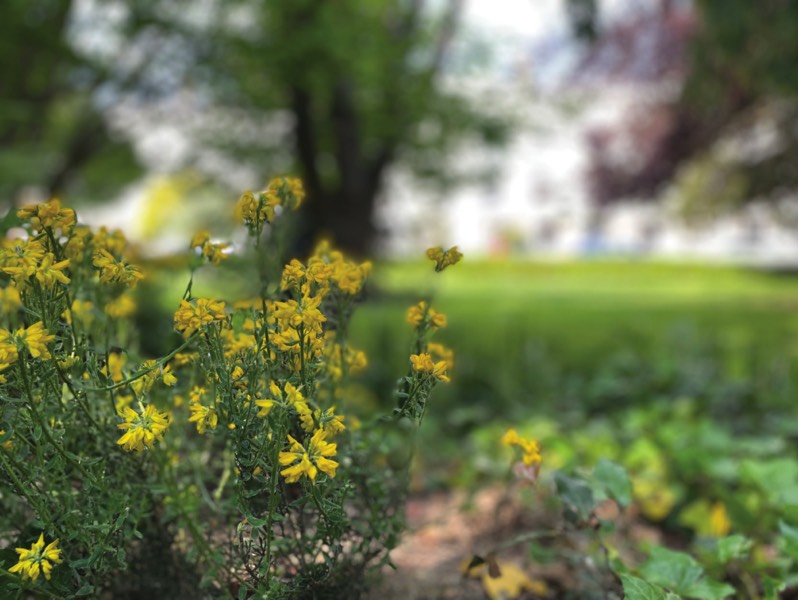
Genista Hispanica
Some new plants have recently been put under the shrubs and trees at various points alongside terrace walk. They are Spanish Gorse (Genista hispanica); more correctly they actually belong to the broom genus, but as well as the small soft leaves that broom has, they also bear quite ferocious spines like gorse, hence the common name. During May and June they also have the bright yellow, sweet smelling flowers familiar on both gorse and broom. Since they belong to the same family as peas, their roots, with the aid of specialised bacteria in nodules, convert atmospheric nitrogen into soluble salts which plants can use as food, hence improving the soil. Several small Spanish Gorse bushes have been planted in places subject to damage with the aim of preventing dogs, children and some adults from walking across bare patches thinking that they are paths. Eventually the bushes will grow into quite large shrubs and do this protective job well, but they can only be planted when very small as they do not adapt well to being moved around. So, at the moment, they are at a rather vulnerable stage. Two of them look as though they have already been destroyed, so do look at these attractive plants, but help to give them room to grow.
Genista hispanica, as its name indicates, is native to Spain, but also to other countries around the Mediterranean such as southern France, Italy, Morocco. It was introduced into Britain in 1759 and has grown well in cultivation here ever since, but has never naturalised to any extent. It is easy to grow and is happy in poor soil, prefers it to be well drained and grows best in full sun, but will do well in partial sunlight, which is the condition it gets in Crescent Garden. It thrives on neglect in a hot dry site and certainly will not tolerate heavy pruning. It is almost completely free of diseases and pests, but aphids can occasionally attack it. The flowers provide copious nectar for bees and other nectar feeders and after the flowers seed pods appear which provide food for birds and small mammals. Although it enjoys heat, it is also hardy to -20*C. It has become invasive, ousting native plants, when introduced into countries where the climate particularly suits it, like Australia, new Zealand and California. That is unlikely to happen in UK.
In traditional Spanish culture, Spanish gorse is associated with the Feast of St.John, which is celebrated on June 24th, when the plant is likely to be in full bloom. It has been used in natural medicine to treat respiratory infections and skin conditions. It is not a common food source for humans, but the flowers can be used to make a tea or be infused into honey to make a sweet. In Andalusia it is used to flavour a type of bred called “pan de gachas”.
So, an attractive, easy care plant for a hot dry bank. Why not try it in your own garden.
Rita Rundle
Crescent Garden, Crescent Road, Alverstoke
alverstokecrescentgarden.co.uk
Genista hispanica, as its name indicates, is native to Spain, but also to other countries around the Mediterranean such as southern France, Italy, Morocco. It was introduced into Britain in 1759 and has grown well in cultivation here ever since, but has never naturalised to any extent. It is easy to grow and is happy in poor soil, prefers it to be well drained and grows best in full sun, but will do well in partial sunlight, which is the condition it gets in Crescent Garden. It thrives on neglect in a hot dry site and certainly will not tolerate heavy pruning. It is almost completely free of diseases and pests, but aphids can occasionally attack it. The flowers provide copious nectar for bees and other nectar feeders and after the flowers seed pods appear which provide food for birds and small mammals. Although it enjoys heat, it is also hardy to -20*C. It has become invasive, ousting native plants, when introduced into countries where the climate particularly suits it, like Australia, new Zealand and California. That is unlikely to happen in UK.
In traditional Spanish culture, Spanish gorse is associated with the Feast of St.John, which is celebrated on June 24th, when the plant is likely to be in full bloom. It has been used in natural medicine to treat respiratory infections and skin conditions. It is not a common food source for humans, but the flowers can be used to make a tea or be infused into honey to make a sweet. In Andalusia it is used to flavour a type of bred called “pan de gachas”.
So, an attractive, easy care plant for a hot dry bank. Why not try it in your own garden.
Rita Rundle
Crescent Garden, Crescent Road, Alverstoke
alverstokecrescentgarden.co.uk
July
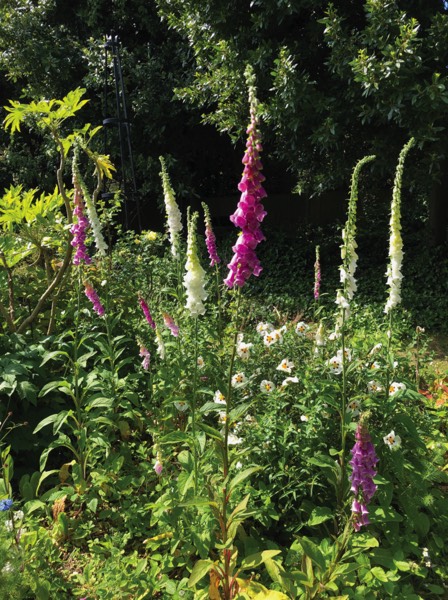
Digitalis Purpurea
A plant very familiar to most of us, both in gardens and in the countryside, is the foxglove, Digitalis purpurea. It is native to Europe, western Asia and north western Africa, but has been introduced and grows well in other parts of the world. It is a spectacular wild flower of woodlands and hedgerows, but will grow anywhere given light dappled shade, plenty of organic matter and damp, but well drained soil; hence its frequent appearance in gardens. Once planted it will reappear year after year wherever its seeds fall and are left undisturbed. It is a biennial, so in the first year of growth it forms a rosette of oval downy leaves and in the second year a single tall flower spike of blooms grows from the centre of the rosette. After flowering and setting seed in the second year the plant will die off and the next generation take its place the following year.
The flowers of D. purpurea range in colour from a vibrant purple, through pink to white and the whole range of these colours can be seen in Crescent Garden. The flowers are asymmetrical with a lower ‘lip’ which is darkly spotted to attract bees, which land on the lip and climb into the tube of the flower following a further pattern of spots to guide bees to the nectar at the end of the flower. During this journey into the flower a bee will be dusted with pollen which it will carry to another foxglove plant, thus ensuring cross pollination and the production of strong seeds.
All parts of a foxglove plant are toxic to humans and most animals, but not the nectar to bees, fortunately. The symptoms of digitalis poisoning include dizziness, vomiting, irregular heartbeat and hallucination. It can result in death, but fortunately the leaves taste so unpleasant that very few people would eat enough to harm them. One way in which poisoning has occurred is that people have confused foxglove with comfrey, which can be brewed into a tea. If fox glove is mistaken for comfrey in this brew there can be fatal consequences. Even contact may irritate skin and eyes. In the past it was an important part of an herbalist’s store. In Nicholas Culpeper’s herbal medicine guide of 1652 he cited its use for healing wounds, as a purgative, for “falling sickness” (epilepsy) and for “a scabby head”! It is no longer used for any of these diseases but a group of medicines called digitalin can be extracted from Digitalis species and are used to treat some heart conditions. It was approved by the Food and Drug Administration in 1998, but its use is declining in favour of other drugs as its over use can cause problems.
The name of the genus, Digitalis, comes from the Latin, digitus, meaning finger; this, in turn, gave rise to the German name for the plant, fingerhut, which can be literally translated as ‘finger hat’, but means ‘thimble’. In Old English the plant came to be called ‘foxes glofa’, this developing into the modern name by which we know it. Folk myths developed about the plant and it was suggested that foxes wore the flowers on their paws to silence stealthy hunting activities! This idea was supported by the fact that foxgloves are often growing plentifully around the woodland places where foxes live.
So, quite a common plant, known for generations, and hence developing an interesting mythology around it.
Rita Rundle
Crescent Garden, Crescent Road, Alverstoke
alverstokecrescentgarden.co.uk
The flowers of D. purpurea range in colour from a vibrant purple, through pink to white and the whole range of these colours can be seen in Crescent Garden. The flowers are asymmetrical with a lower ‘lip’ which is darkly spotted to attract bees, which land on the lip and climb into the tube of the flower following a further pattern of spots to guide bees to the nectar at the end of the flower. During this journey into the flower a bee will be dusted with pollen which it will carry to another foxglove plant, thus ensuring cross pollination and the production of strong seeds.
All parts of a foxglove plant are toxic to humans and most animals, but not the nectar to bees, fortunately. The symptoms of digitalis poisoning include dizziness, vomiting, irregular heartbeat and hallucination. It can result in death, but fortunately the leaves taste so unpleasant that very few people would eat enough to harm them. One way in which poisoning has occurred is that people have confused foxglove with comfrey, which can be brewed into a tea. If fox glove is mistaken for comfrey in this brew there can be fatal consequences. Even contact may irritate skin and eyes. In the past it was an important part of an herbalist’s store. In Nicholas Culpeper’s herbal medicine guide of 1652 he cited its use for healing wounds, as a purgative, for “falling sickness” (epilepsy) and for “a scabby head”! It is no longer used for any of these diseases but a group of medicines called digitalin can be extracted from Digitalis species and are used to treat some heart conditions. It was approved by the Food and Drug Administration in 1998, but its use is declining in favour of other drugs as its over use can cause problems.
The name of the genus, Digitalis, comes from the Latin, digitus, meaning finger; this, in turn, gave rise to the German name for the plant, fingerhut, which can be literally translated as ‘finger hat’, but means ‘thimble’. In Old English the plant came to be called ‘foxes glofa’, this developing into the modern name by which we know it. Folk myths developed about the plant and it was suggested that foxes wore the flowers on their paws to silence stealthy hunting activities! This idea was supported by the fact that foxgloves are often growing plentifully around the woodland places where foxes live.
So, quite a common plant, known for generations, and hence developing an interesting mythology around it.
Rita Rundle
Crescent Garden, Crescent Road, Alverstoke
alverstokecrescentgarden.co.uk
August
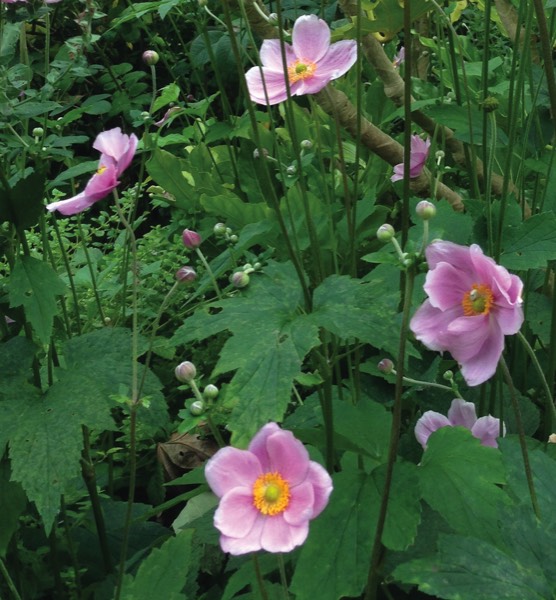
Eriocapitella Hupehensis
I think many of us are familiar with the Japanese anemone (Eriocapitella hupehensis) whose tall swaying stems holding saucer shaped pink flowers make a statement in our flowerbeds from August until the first frosts damage them. The plant was brought to Britain in 1843 by plant explorer, Robert Fortune. He first saw it in Japan, hence the name by which it has always been known in this country. It is, in fact, native to China, particularly to Hupei province, hence its specific name. The plant’s name in Chinese is da po wan hua hua, which means broken bowl flower, an apt description of its appearance. It has been cultivated in China for centuries, back to the Tang dynasty (618-907) and has since spread and naturalised over large parts of Asia, S.E. Asia and the Himalayas.
Japanese anemone is a wonderful plant with which to enhance the back of an herbaceous border. Early in the year clusters of interestingly shaped leaves appear above ground and then in mid-summer stems shoot up to heights of 12 to 40 inches bearing the flowers. All those in Crescent Garden are pale pink, but there are varieties which are white or a much darker pink. The coloured part of the flower is actually composed of sepals, the parts of a flower which are usually green and enclose the flower bud. There are no real petals. Inside the coloured sepals is a ring of bright yellow pollen bearing stamens surrounding a central mound of pistils, the female part of the flower, which will develop into seeds when the flower has been fertilised. The copious pollen and nectar attract many pollinators including bumble bees, honey bees, hover flies and others. Flowering relatively late in the summer these plants enable insects to build up supplies to last them over the winter.
Japanese anemones are very easy to grow in almost any soil, but they do enjoy a good bit of humus in a well drained soil in sun or part shade. They will not flower if they are in deep shade or very dry and do not enjoy cold winter wet (but then, who does?) The plants are pretty well immune to attack by pests of various kinds. So an ideal plant for your garden.
However, as many people know who already grow Japanese anemones, they are so happy and easy to grow that they can become a problem if not carefully cultivated. They have a very strong root system with rhizomes which grow and seek new ground so the plant will very easily spread if not constantly watched. New bits that you don’t want, need to be dug out immediately and very thoroughly. Even a small piece of root left in the ground will develop into a new plant. This does mean, however, that Japanese anemones are very easy to propagate.
Despite the problem posed by the plant’s ability to spread, its advantages far outweigh its disadvantages. Do come and look at those growing in Crescent Garden and try some in your own garden.
Rita Rundle
Crescent Garden, Crescent Road, Alverstoke
alverstokecrescentgarden.co.uk
Japanese anemone is a wonderful plant with which to enhance the back of an herbaceous border. Early in the year clusters of interestingly shaped leaves appear above ground and then in mid-summer stems shoot up to heights of 12 to 40 inches bearing the flowers. All those in Crescent Garden are pale pink, but there are varieties which are white or a much darker pink. The coloured part of the flower is actually composed of sepals, the parts of a flower which are usually green and enclose the flower bud. There are no real petals. Inside the coloured sepals is a ring of bright yellow pollen bearing stamens surrounding a central mound of pistils, the female part of the flower, which will develop into seeds when the flower has been fertilised. The copious pollen and nectar attract many pollinators including bumble bees, honey bees, hover flies and others. Flowering relatively late in the summer these plants enable insects to build up supplies to last them over the winter.
Japanese anemones are very easy to grow in almost any soil, but they do enjoy a good bit of humus in a well drained soil in sun or part shade. They will not flower if they are in deep shade or very dry and do not enjoy cold winter wet (but then, who does?) The plants are pretty well immune to attack by pests of various kinds. So an ideal plant for your garden.
However, as many people know who already grow Japanese anemones, they are so happy and easy to grow that they can become a problem if not carefully cultivated. They have a very strong root system with rhizomes which grow and seek new ground so the plant will very easily spread if not constantly watched. New bits that you don’t want, need to be dug out immediately and very thoroughly. Even a small piece of root left in the ground will develop into a new plant. This does mean, however, that Japanese anemones are very easy to propagate.
Despite the problem posed by the plant’s ability to spread, its advantages far outweigh its disadvantages. Do come and look at those growing in Crescent Garden and try some in your own garden.
Rita Rundle
Crescent Garden, Crescent Road, Alverstoke
alverstokecrescentgarden.co.uk
September

Ferns in Crescent Garden
There are several different types of fern in Crescent Garden, most of them planted in the shade under trees and bushes alongside terrace walk. One of the most distinctive is the hart’s tongue fern (Asplenium scolopendrium). There are several of these behind the monkey puzzle tree on the western lawn. It is an unusual fern as it is the only one in Britain which does not have the divided frond, familiar from such ferns as bracken. It has deep green, slightly shiny strap-like fronds with wavy edges and pointed tips, making it look like a deer’s tongue; hence its name, hart being an old name for a deer.
All ferns reproduce by means of spores and hart’s tongue has its spores in strips called sori on the back of some fronds. These strips were thought to look like centipedes’ legs, hence its Greek based specific name, scolopendrium, from the Greek for centipede. The spores ripen and are spread during August and September. A. scolopendrium is native to UK, but is found throughout the northern hemisphere from USA to Asia and including NW Africa. It grows best in shade in damp, base rich soils, but often pops up in crevices in rocks, walls and trees. The shallow, wide spreading root system can help to improve soil by aerating it and breaking up compacted soil. This type of root system is also what allows it to colonise the small spaces mentioned above.
It is said to be an Ancient Woodland Indicator Species and finding it in the wild could indicate a rare and special habitat. It is a long-lived species and some plants are known to live for 100 years in the wild. Its spores, however, are prolific and readily germinate in all sorts of conditions. I have found small plants springing up in cracks in the paving of my own garden, though no hart’s tongue ferns have ever been planted there.
Ancient woodlands are defined as those that have existed relatively undisturbed by human development since 1600 in England, Wales and N. Ireland and since 1750 in Scotland. This is when maps started to be reasonably accurate and indicate that these places have had tree cover for hundreds of years. Ancient woodlands, therefore, display a rich and complex habitat, home to more threatened species than any other in UK:- insects, birds, mammals and fungi as well as the actual trees. Such woods cover only 2.5% of the UK. Not that the ferns in Crescent Garden can lay claim to any great age; they were planted some time after the gardens were re-established in the 1990s, though some of the trees and bushes under which they grow were planted when the garden was first established in 1830.
Hart’s tongue was used medicinally in the 1800s, mainly as an extract from the root and was thought to be good for coughs, sore throats and digestive problems. In medieval times it was used to relieve gout, heal wounds and remove warts and pustules. Modern research has not established the efficacy of any of these uses, but it is known that in large quantities the fern can be poisonous, so it is not recommended for self-treatment. In folk law, it was once thought that it could be used to break a spell cast by a witch. I don’t think there would be much call or that particular use today!
So, an attractive, easily grown plant. Try it in a shady corner of your own garden and come and admire it in Crescent Garden.
Rita Rundle
Crescent Garden, Crescent Road, Alverstoke
alverstokecrescentgarden.co.uk
All ferns reproduce by means of spores and hart’s tongue has its spores in strips called sori on the back of some fronds. These strips were thought to look like centipedes’ legs, hence its Greek based specific name, scolopendrium, from the Greek for centipede. The spores ripen and are spread during August and September. A. scolopendrium is native to UK, but is found throughout the northern hemisphere from USA to Asia and including NW Africa. It grows best in shade in damp, base rich soils, but often pops up in crevices in rocks, walls and trees. The shallow, wide spreading root system can help to improve soil by aerating it and breaking up compacted soil. This type of root system is also what allows it to colonise the small spaces mentioned above.
It is said to be an Ancient Woodland Indicator Species and finding it in the wild could indicate a rare and special habitat. It is a long-lived species and some plants are known to live for 100 years in the wild. Its spores, however, are prolific and readily germinate in all sorts of conditions. I have found small plants springing up in cracks in the paving of my own garden, though no hart’s tongue ferns have ever been planted there.
Ancient woodlands are defined as those that have existed relatively undisturbed by human development since 1600 in England, Wales and N. Ireland and since 1750 in Scotland. This is when maps started to be reasonably accurate and indicate that these places have had tree cover for hundreds of years. Ancient woodlands, therefore, display a rich and complex habitat, home to more threatened species than any other in UK:- insects, birds, mammals and fungi as well as the actual trees. Such woods cover only 2.5% of the UK. Not that the ferns in Crescent Garden can lay claim to any great age; they were planted some time after the gardens were re-established in the 1990s, though some of the trees and bushes under which they grow were planted when the garden was first established in 1830.
Hart’s tongue was used medicinally in the 1800s, mainly as an extract from the root and was thought to be good for coughs, sore throats and digestive problems. In medieval times it was used to relieve gout, heal wounds and remove warts and pustules. Modern research has not established the efficacy of any of these uses, but it is known that in large quantities the fern can be poisonous, so it is not recommended for self-treatment. In folk law, it was once thought that it could be used to break a spell cast by a witch. I don’t think there would be much call or that particular use today!
So, an attractive, easily grown plant. Try it in a shady corner of your own garden and come and admire it in Crescent Garden.
Rita Rundle
Crescent Garden, Crescent Road, Alverstoke
alverstokecrescentgarden.co.uk
October
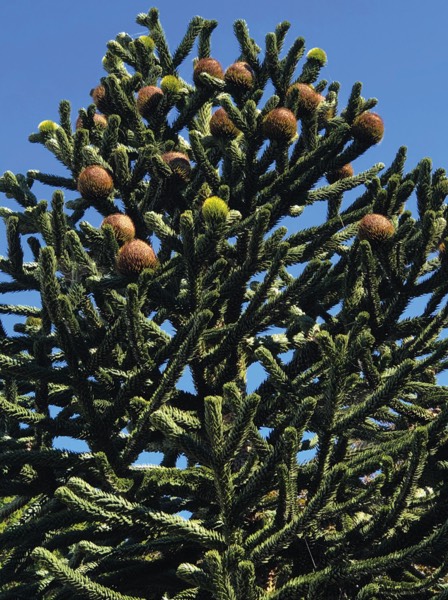
Araucaria Araucana
Our Araucaria araucana, more commonly known as the monkey puzzle tree, dominates the western lawn of Crescent Garden. It was planted there thirty years ago, when the garden was re-established, replacing one which was old and damaged. It is native to the lower slopes of the Andes in Chile and Argentina where it is very much an endangered species and in Chile it was declared a national monument in 1976 to protect it from logging and in 1990 logging was completely banned. A much greater threat to its survival in the wild, however, is fire. Fires burned hundreds of acres in 2001-2 and in 2015 70% of the remaining trees were destroyed, some of which were over 1,300 year old. They commonly live to over 700 years. Although young trees like ours are a neat pyramidal shape, old trees lose lower branches and tend to look like tall thin umbrellas. The tree is sometimes called a ‘living fossil’ as it appears in the fossil record and has survived for 200 million years:- it was contemporary with the dinosaurs.
It was first brought to England in 1795 by plant collector, Archibald Menzies. He was commissioned by Kew to collect plants in South America and while at dinner with the governor of Chile he kept a few seeds which were served as part of the meal. He grew on five of the seeds and gave the plants to Joseph Banks at Kew. These were the very first monkey puzzles in England and all the early plants derived from these seedlings were very much the preserve of stately homeowners. In Victorian times, however, they became very popular and were planted in the gardens of more modest homes and in parks. They were sometimes cultivated as small trees in the middle of the formal brightly coloured beds, so beloved of Victorian gardeners. When they became too large for such a position they were dug up and a small replacement planted. In some modest Victorian gardens, the formal bedding has long since disappeared leaving a large monkey puzzle dominating a small garden. At Biddulph Grange in Staffordshire, Victorian formal bedding, plus monkey puzzle, is still practised, but at ten years old, the young monkey puzzle is not thrown away, but planted to contribute to a ‘monkey puzzle forest’.
The tree is dioecious, that is there are male and female cones on separate plants. Ours is female and for the past two or three years has been producing prominent rounded female cones near the top of the tree. As far as I am aware it has never produced any of the nut like seeds as there is no male tree nearby to supply the pollen needed to fertilise it. In their native area the seeds are collected and roasted as an important part of the diet. They are also eaten by various rodents. In this country jays and squirrels are very fond of the seeds. Such animals must approach the tree very carefully as the leaves are thick and scale like with sharp edges and tips. When any gardening is needed on or around the tree in Crescent Garden the person doing it must be very careful or they can be badly cut.
The famous Whitby jet favoured by Victorians, particularly widows, is the fossilised wood of a species of Araucaria.
Another species of Araucaria is A. heterophylla or Norfolk Island pine. This is not actually a pine, but grew exclusively on Norfolk Island in the Pacific Ocean 1,676 kms NE of Sydney. The island was first sighted by Captain Cook in 1774 and when he reported the presence of the huge straight growing ‘pine trees’ it was thought that they would be ideal for making ships’ masts. A convict settlement was created there in 1788 with the idea of using the convicts to harvest the trees, but the wood was found to be too brittle for making masts and spars. The convict settlement remained there until 1855 and became notorious as a place of severe discipline and punishment.
There are relatively few Norfolk Island pines on Norfolk Island now as the wood has been used extensively for other uses than ships’ masts, but hundreds have been planted along the sea fronts of many Australian resorts as they grow tall and straight in salty, windy conditions and sandy soil. They do not grow in UK as they require more warmth than most of this country can offer, but they can be seen in Tresco Abbey Gardens on the Isle of Scilly.
Come and admire the straight growing spiny monkey puzzle tree in Crescent Garden, but it would be advisable not to touch it!
Rita Rundle
Crescent Garden, Crescent Road, Alverstoke
alverstokecrescentgarden.co.uk
It was first brought to England in 1795 by plant collector, Archibald Menzies. He was commissioned by Kew to collect plants in South America and while at dinner with the governor of Chile he kept a few seeds which were served as part of the meal. He grew on five of the seeds and gave the plants to Joseph Banks at Kew. These were the very first monkey puzzles in England and all the early plants derived from these seedlings were very much the preserve of stately homeowners. In Victorian times, however, they became very popular and were planted in the gardens of more modest homes and in parks. They were sometimes cultivated as small trees in the middle of the formal brightly coloured beds, so beloved of Victorian gardeners. When they became too large for such a position they were dug up and a small replacement planted. In some modest Victorian gardens, the formal bedding has long since disappeared leaving a large monkey puzzle dominating a small garden. At Biddulph Grange in Staffordshire, Victorian formal bedding, plus monkey puzzle, is still practised, but at ten years old, the young monkey puzzle is not thrown away, but planted to contribute to a ‘monkey puzzle forest’.
The tree is dioecious, that is there are male and female cones on separate plants. Ours is female and for the past two or three years has been producing prominent rounded female cones near the top of the tree. As far as I am aware it has never produced any of the nut like seeds as there is no male tree nearby to supply the pollen needed to fertilise it. In their native area the seeds are collected and roasted as an important part of the diet. They are also eaten by various rodents. In this country jays and squirrels are very fond of the seeds. Such animals must approach the tree very carefully as the leaves are thick and scale like with sharp edges and tips. When any gardening is needed on or around the tree in Crescent Garden the person doing it must be very careful or they can be badly cut.
The famous Whitby jet favoured by Victorians, particularly widows, is the fossilised wood of a species of Araucaria.
Another species of Araucaria is A. heterophylla or Norfolk Island pine. This is not actually a pine, but grew exclusively on Norfolk Island in the Pacific Ocean 1,676 kms NE of Sydney. The island was first sighted by Captain Cook in 1774 and when he reported the presence of the huge straight growing ‘pine trees’ it was thought that they would be ideal for making ships’ masts. A convict settlement was created there in 1788 with the idea of using the convicts to harvest the trees, but the wood was found to be too brittle for making masts and spars. The convict settlement remained there until 1855 and became notorious as a place of severe discipline and punishment.
There are relatively few Norfolk Island pines on Norfolk Island now as the wood has been used extensively for other uses than ships’ masts, but hundreds have been planted along the sea fronts of many Australian resorts as they grow tall and straight in salty, windy conditions and sandy soil. They do not grow in UK as they require more warmth than most of this country can offer, but they can be seen in Tresco Abbey Gardens on the Isle of Scilly.
Come and admire the straight growing spiny monkey puzzle tree in Crescent Garden, but it would be advisable not to touch it!
Rita Rundle
Crescent Garden, Crescent Road, Alverstoke
alverstokecrescentgarden.co.uk
November
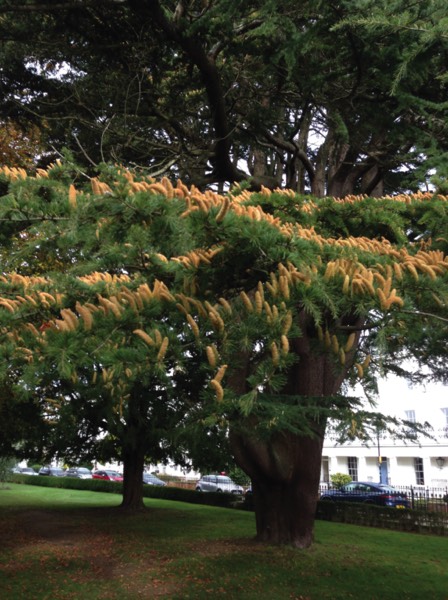
Cedrus Libani
Many of you will have visited parks or seen the lawns of stately homes dominated by magnificent cedar trees their almost horizontal branches making a bold statement of grandeur to mark the owner’s position in the world. Cedar was planted in the grounds of nearly every stately home from 1740 onwards, but is not so commonly grown now.
The Cedar of Lebanon (Cedrus libani) in Crescent Garden was almost certainly planted in 1830, when the garden was laid out and the houses and hotel were built. It dominates the western lawn near the fountain, but is not easily seen in its full beauty as it is so close to the beech tree nearby. No doubt when it was first planted the small tree’s lovely shape could be admired fully. What can be seen easily at the moment are the male cones attached to the upper surfaces of branches and looking like groups of candles. They produce copious pollen which will fertilise the female cones to enable them to produce the large barrel shaped mature cones that stand upright at the ends of short shoots. They are full of seeds, which will be scattered by the wind a year after pollination. Unlike the seeds of the nearby pine tree they do not form food for squirrels as each seed has two or three blisters of unpleasant tasting resin attached to it.
Cedar libani is native to Lebanon and the Eastern Mediterranean. It is the national emblem of Lebanon and appears on the centre of the Lebanese flag. In areas where the tree is native cedar wood has been important to the human race for thousands of years. In antiquity cedar wood was used to build major buildings such as temples and palaces due to its great size and durability. The tree also produces an oil used to make ointments and antiseptics; it was an important constituent of the embalming fluid used for preserving the dead in ancient Egypt. Cedar wood can also be used as an insect repellent, so is often used to make chests for storing clothes and linen. It is mentioned in this function in The Iliad when Priam goes to fetch treasure from a cedar-roofed storage chamber. Cedars are also mentioned with admiration many times in the bible, particularly in the Old Testament and always as something very valuable. The wood is very fragrant, so is still popular for making chests and cupboards. Cedar wood is also traditionally used for making shoe trees as it can absorb water and deodorise.
Many species of cedar are also very suitable to train as bonsai.
So, large or small, old or young, they are beautiful trees. Come and admire the one in Crescent Garden.
Rita Rundle
Crescent Garden, Crescent Road, Alverstoke
alverstokecrescentgarden.co.uk
The Cedar of Lebanon (Cedrus libani) in Crescent Garden was almost certainly planted in 1830, when the garden was laid out and the houses and hotel were built. It dominates the western lawn near the fountain, but is not easily seen in its full beauty as it is so close to the beech tree nearby. No doubt when it was first planted the small tree’s lovely shape could be admired fully. What can be seen easily at the moment are the male cones attached to the upper surfaces of branches and looking like groups of candles. They produce copious pollen which will fertilise the female cones to enable them to produce the large barrel shaped mature cones that stand upright at the ends of short shoots. They are full of seeds, which will be scattered by the wind a year after pollination. Unlike the seeds of the nearby pine tree they do not form food for squirrels as each seed has two or three blisters of unpleasant tasting resin attached to it.
Cedar libani is native to Lebanon and the Eastern Mediterranean. It is the national emblem of Lebanon and appears on the centre of the Lebanese flag. In areas where the tree is native cedar wood has been important to the human race for thousands of years. In antiquity cedar wood was used to build major buildings such as temples and palaces due to its great size and durability. The tree also produces an oil used to make ointments and antiseptics; it was an important constituent of the embalming fluid used for preserving the dead in ancient Egypt. Cedar wood can also be used as an insect repellent, so is often used to make chests for storing clothes and linen. It is mentioned in this function in The Iliad when Priam goes to fetch treasure from a cedar-roofed storage chamber. Cedars are also mentioned with admiration many times in the bible, particularly in the Old Testament and always as something very valuable. The wood is very fragrant, so is still popular for making chests and cupboards. Cedar wood is also traditionally used for making shoe trees as it can absorb water and deodorise.
Many species of cedar are also very suitable to train as bonsai.
So, large or small, old or young, they are beautiful trees. Come and admire the one in Crescent Garden.
Rita Rundle
Crescent Garden, Crescent Road, Alverstoke
alverstokecrescentgarden.co.uk
December
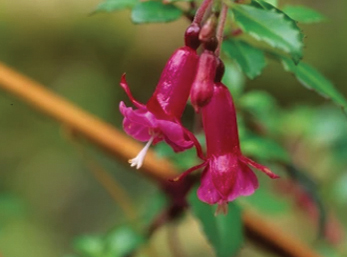
Fuchsia microphylla
Some of you who walk through Crescent Garden regularly will have noticed unusual things happening under the old tulip tree just inside the western gate. The tree has for some years been under attack by honey fungus (Armillaria), one of the most persistent organisms to attack plants, especially woody ones. Although there are various ‘cures’ for honey fungus, few of them prove to be really effective and the best advice about conquering it is to keep plants as healthy as possible. This is what we are trying to do with the tulip tree. The tree has important roots very near the surface and to protect them from foot fall the area around the tree was covered with ivy, but in recent years that ivy has died off, so a new protection for these roots was devised.
Back in the summer several bulk bags of topsoil were delivered to the site, a wooden edging put in place and the soil spread evenly over the space to be protected. This has created a new planting area. Between this new bed and the box hedge a stone path has been made and we would be pleased if people could walk on the paving stones rather than the grass, especially now that the area has become so wet in the recent rain.
An interesting range of shade loving, shallow rooted plants has been introduced here.
Fuchsia microphylla
This plant is native to Mexico and Guatemala and was first recorded at Kew Gardens in 1827. The specific name, microphylla, means small leaves and it is, indeed, a fuchsia with not only small leaves, but very small flowers, which usually appear in September and October, but in the mild weather we have been experiencing recently it was still producing a few flowers in November and early December. It can grow into a small shrub about six foot high with a three foot spread and most important of all in its new home, it is resistant to honey fungus.
Back in the summer several bulk bags of topsoil were delivered to the site, a wooden edging put in place and the soil spread evenly over the space to be protected. This has created a new planting area. Between this new bed and the box hedge a stone path has been made and we would be pleased if people could walk on the paving stones rather than the grass, especially now that the area has become so wet in the recent rain.
An interesting range of shade loving, shallow rooted plants has been introduced here.
Fuchsia microphylla
This plant is native to Mexico and Guatemala and was first recorded at Kew Gardens in 1827. The specific name, microphylla, means small leaves and it is, indeed, a fuchsia with not only small leaves, but very small flowers, which usually appear in September and October, but in the mild weather we have been experiencing recently it was still producing a few flowers in November and early December. It can grow into a small shrub about six foot high with a three foot spread and most important of all in its new home, it is resistant to honey fungus.
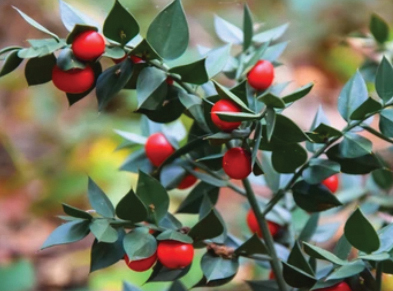
Butcher’s broom (Ruscus aesculeatus)
This plant is native to the whole Eurasian area and parts of North Africa. It spreads due to the formation of underground rhizomes and can form a dense ground cover about 18 inches high. What look like spiny leaves are actually flattened stems called cladodes which bear small inconspicuous flowers, followed by bright red berries, a few of which are in evidence now. The common name for the plant, butcher’s broom, came from the use of the plant by butchers to scrub the old wooden chopping blocks which used to dominate butchers’ shops. Recent research has discovered antibacterial compounds in the plant, giving another good reason for the use of the plant in this way, though it was unsuspected years ago.
This plant is native to the whole Eurasian area and parts of North Africa. It spreads due to the formation of underground rhizomes and can form a dense ground cover about 18 inches high. What look like spiny leaves are actually flattened stems called cladodes which bear small inconspicuous flowers, followed by bright red berries, a few of which are in evidence now. The common name for the plant, butcher’s broom, came from the use of the plant by butchers to scrub the old wooden chopping blocks which used to dominate butchers’ shops. Recent research has discovered antibacterial compounds in the plant, giving another good reason for the use of the plant in this way, though it was unsuspected years ago.
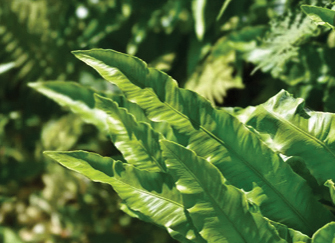
Harts tongue fern (Asplenium scolopendrium)
This common fern is native to Europe, the Middle East and the Canary Islands. Plants in the Eastern United States are considered to be the naturalised descendants of cultivated plants. It is a hardy fern of damp shady places and can also be found growing out of walls and rocky places. The fronds are not subdivided like most ferns but are tongue shaped with pointed, curly tips making them look remarkably like the tongue of a deer. On the back of each frond are strips of sori containing the reproductive spores. These are thought to look remarkably like centipedes, which account for the specific name which is the latin for centipede.
Wild daffodil (Narcissus pseudonarcissus)
A large group of these daffodils has been placed among the other plants in the bed and will bloom in March and April. They are native to Europe, from Spain , north to England and Wales and East to Germany. Wild plants grow in woods, grassland and on rocky ground, but in Britain native populations have decreased since the 19th century due to intensification of agriculture. They survive in several protected nature reserves. If William Wordsworth were alive today he would be unlikely to be able to say,
“When all at once I saw a crowd,
A host of golden daffodils”
as he strolled round the Lake District, but there are still crowds in the Dove Valley and parts of Gloucestershire.
Scented pelargoniums
Several different varieties of these have been planted round the edge of the bed and their variegated leaves and flowers in spring and summer will add to the colour in the area.
Rita Rundle
Crescent Garden, Crescent Road, Alverstoke
alverstokecrescentgarden.co.uk
This common fern is native to Europe, the Middle East and the Canary Islands. Plants in the Eastern United States are considered to be the naturalised descendants of cultivated plants. It is a hardy fern of damp shady places and can also be found growing out of walls and rocky places. The fronds are not subdivided like most ferns but are tongue shaped with pointed, curly tips making them look remarkably like the tongue of a deer. On the back of each frond are strips of sori containing the reproductive spores. These are thought to look remarkably like centipedes, which account for the specific name which is the latin for centipede.
Wild daffodil (Narcissus pseudonarcissus)
A large group of these daffodils has been placed among the other plants in the bed and will bloom in March and April. They are native to Europe, from Spain , north to England and Wales and East to Germany. Wild plants grow in woods, grassland and on rocky ground, but in Britain native populations have decreased since the 19th century due to intensification of agriculture. They survive in several protected nature reserves. If William Wordsworth were alive today he would be unlikely to be able to say,
“When all at once I saw a crowd,
A host of golden daffodils”
as he strolled round the Lake District, but there are still crowds in the Dove Valley and parts of Gloucestershire.
Scented pelargoniums
Several different varieties of these have been planted round the edge of the bed and their variegated leaves and flowers in spring and summer will add to the colour in the area.
Rita Rundle
Crescent Garden, Crescent Road, Alverstoke
alverstokecrescentgarden.co.uk

© 2022 Friends of Crescent Garden | Contact us | Data Protection Policy
Crescent Garden, Crescent Road, Alverstoke, Gosport, Hampshire PO12 2BB
